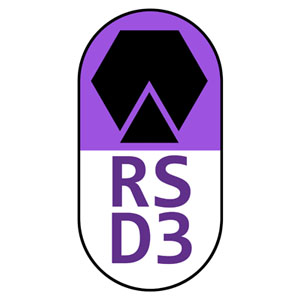Training and Documentation
Collection of Current Tutorials
At present, there are various entry points to get started with self-guided tutorials for the recently developed tools and methods –
The Meeko documentation on docking preparation outlines procedures for converting molecular structures into PDBQT files, which are essential for docking simulations with tools like AutoDock-GPU and AutoDock Vina. The documentation provides instructions for both command-line usage and Python scripting.
- Ligand Preparation with Meeko:
(Meeko Documentation) https://meeko.readthedocs.io/en/release-doc/lig_prep_basic.html
- Receptor Preparation with Meeko:
(Meeko Documentation) https://meeko.readthedocs.io/en/release-doc/cli_rec_prep.html
AutoGridFR (or AGFR in short) is a software program facilitating the calculation of AutoDock4 affinity maps. It is usable from the command line of through Graphical User Interface (GUI). The AGFR documentation provides comprehensive guidance on preparing biological macromolecules (receptors) for docking simulations using AutoDockFR and AutoDock CrankPep.
- Receptor Preparation for ADFR/ADCP with AGFR
(AGFR Documentation) https://ccsb.scripps.edu/agfr/documentation/
- Batched Ligand Preparation with Meeko
(Meeko Documentation) https://meeko.readthedocs.io/en/release-doc/tutorial1.html#prepare-ligands-in-batch-from-a-smi-file
Both AutoDock Vina v1.2.x and AutoDock-GPU offer options for a batched docking pipeline. Refer to their respective documentation for detailed usage instructions.
- Batched Docking Pipeline with AutoDock-Vina
(Vina Documentation) https://autodock-vina.readthedocs.io/en/latest/changes.html#id1
- Batched Docking Pipeline with AutoDock-GPU
(AutoDock-GPU Usage) https://github.com/ccsb-scripps/AutoDock-GPU?tab=readme-ov-file#supported-arguments
Python package Ringtail can be used to filter, and visualize docking data from virtual screening. Ringtail reads collections of virtual screening results in form of Docking Log File (DLG) from AutoDock-GPU, or docking result strings or PDBQT from AutoDock-Vina, and manage the result data in SQLite databases.
- Analysis and Data Management by Command-line Scripts in Ringtail
(Ringtail Documentation) https://ringtail.readthedocs.io/en/latest/cmdline.html
- Python Scripting with Ringtail
(Ringtail Documentation) https://ringtail.readthedocs.io/en/latest/api.html
Raccoon2 is a graphical user interface (GUI) designed to streamline molecular docking workflows with AutoDock and AutoDock Vina. It simplifies the preparation of docking projects by allowing users to configure input files, set docking parameters, and manage batch processes.
- Configure a Virtual Screening Job with Raccoon2
(Raccon2 Resource Site) https://autodock.scripps.edu/resources/raccoon2/
- Peptide Docking with AutoDock CrankPep:
(ADCPv1.1 Documentation) https://ccsb.scripps.edu/adcpv11/
- AutoDock4Zn with AutoDock Vina v1.2.x:
(Vina Documentation) https://autodock-vina.readthedocs.io/en/latest/docking_zinc.html
- Hydrated Docking with AutoDock Vina v1.2.x:
(Vina Documentation) https://autodock-vina.readthedocs.io/en/latest/docking_hydrated.html
- Reactive Docking with AutoDock-GPU:
(Meeko Documentation) https://meeko.readthedocs.io/en/release-doc/tutorial2.html
- Covalent (Tethered) Docking with AutoDock-GPU:
(Meeko Documentation) https://meeko.readthedocs.io/en/release-doc/tutorial3.html
- AutoDock Vina v1.2.x:
(Vina Documentation) https://autodock-vina.readthedocs.io/en/latest/
- AutoDock-GPU
(AutoDock-GPU Usage) https://github.com/ccsb-scripps/AutoDock-GPU?tab=readme-ov-file#basic-command
- AutoDockFR:
(ADFR Documentation) https://ccsb.scripps.edu/adfr/documentation/
- AutoDockCrankPep:
(ADCPv1.1 Documentation) https://ccsb.scripps.edu/adcpv11/documentation/
Sample Sessions in Cloud-Based Environment
Currently as part of the Meeko and Vina documentations, the following Google Colab notebooks are presented as sample sessions for different types of docking in a cloud-based environment –
Basic Docking with Vina
The basic docking example is a rewrite based on the original basic docking example. In this example, a small molecule ligand (Imatinib, PDB token STI) is docked back to a hollow protein structure of mouse c-Abl (PDB token 1IEP) to reproduce the complex structure. A docked pose that closely resembles the original position of the ligand is expected among the top-ranked poses.
Flexible Docking with Vina
The flexible docking example is a rewrite based on the original flexible docking example. In this example, a variant of Imatinib (PDB token PRC) is docked back to a hollow protein structure of mouse c-Abl (PDB token 1FPU) to reproduce the complex structure. Additionally, Thr315 is set to be a flexible residue. A docked pose that closely resembles the original position of the ligand and a flipped Thr315 are expected among the top-ranked poses.
Using AD4SF in Vina
The using AutoDock4 (AD4) scoring function (SF) example is a rewrite based on the corresponding part of the original basic docking example. This example conducts the same redocking experiment as in Basic docking with the AutoDock4 scoring function instead of Vina. To do this, Autogrid4 is used to compute the grid maps, as an additional step after receptor preparation.
Basic Docking with an RNA Receptor
The basic docking example is developed after the implementation of chemical templates for common nucleotides in Meeko, which enables the preparation of RNA/DNA receptors. In this example, a small molecule inhibitor (Ribocil B, PDB token 51B) is docked back to a hollow protein structure of a bacteria FMN riboswitch (PDB token 5C45) to reproduce the complex structure.
Basic Docking with Cofactors
Reactive Docking with AD-GPU
The reactive docking example is based on reactive docking method that has been developed for high-throughput virtual screenings of reactive species. In this example, a small molecule substrate (Adenosine monophosphate, PDB token AMP) is targeting at the catalytic histidine residue of a hollow protein structure of bacteria RNA 3’ cyclase (PDB token 3KGD) to generate the near-attack conformation for the formation of the phosphoamide bond. A docked pose that closely resembles the original position of the ligand is expected among the top-ranked poses.
The covalent docking example is based on the two-point attractor and flexible side chain method. In this example, a small molecule substrate (Adenosine monophosphate, PDB token AMP) is attached onto the catalytic histidine residue of a hollow protein structure of bacteria RNA 3’ cyclase (PDB token 3KGD) to reproduce the covalent intermediate complex structure. A docked pose that closely resembles the original position of the ligand is expected among the top-ranked poses.

